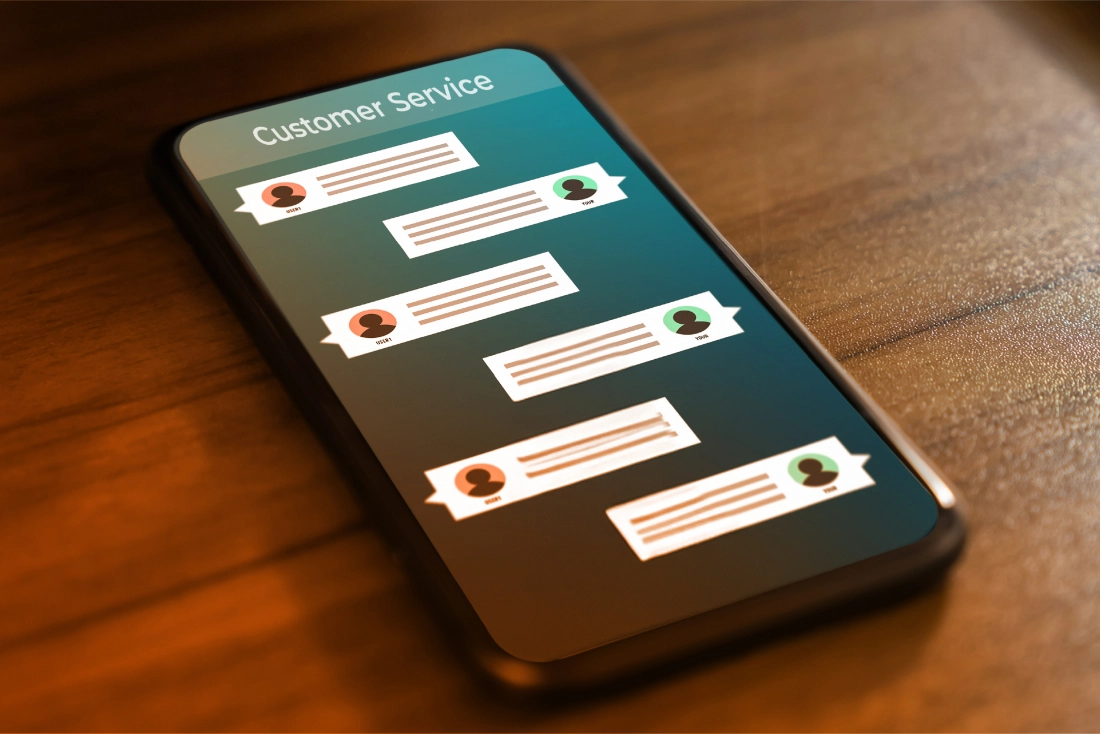Customer service has come a long way, from its roots in face-to-face interactions and phone support to today's sophisticated digital platforms. The latest phase in this evolution is about shifting from human-led processes to AI-driven solutions. According to Gartner, by 2025, 80% of customer service and support organizations will utilize generative AI technology to enhance agent productivity and elevate the overall customer experience (CX).
What AI is capable of doing with chatbots and virtual assistants is fascinating. It can provide faster and more personalized service, cut costs, manage routine inquiries, speed up responses, and enhance customer satisfaction. 64% of business owners believe AI will improve customer relationships.
As AI advances, it’s shaping a future where customer support becomes quicker, smarter, and more tailored. According to Forbes, here are a few ways AI is improving customer experience:

What’s an LLM, and Why Does It Matter for Customer Experience?
LLMs, or large language models, are the brainpower behind smart AI systems that can understand and produce text just like a human would. These models are trained on massive data, allowing them to process and generate language accurately.
As a result, LLMs are becoming increasingly important for customer success. They help businesses deliver more personalized, efficient, and scalable support. Across industries, companies are adopting llm for customer service, making interactions more seamless and meaningful.
LLM Use Cases in Customer Service & Support

Elevate Customer Experience
AI is transforming customer interactions by offering a level of personalization that feels almost intuitive. By leveraging techniques like contextual embeddings and memory mechanisms, LLMs can recall previous interactions, preferences, and behaviors to create context-aware conversations, like how Netflix tailors content recommendations based on a user's viewing history.
These models also enable dynamic product and service recommendations by analyzing customer data, similar to how Amazon suggests products based on browsing history and purchase patterns.
Moreover, LLMs enhance content delivery by adjusting the format and messaging to align with individual preferences, as seen in Spotify’s personalized playlists and notifications based on listening habits.
Automate Routine Tasks
LLMs can precisely categorize and route customer inquiries, determining whether a request belongs to billing, technical support, or general information. This capability allows chatbots to direct queries to the appropriate department or handle them autonomously if possible. It reduces wait times and operational costs.
Moreover, LLMs excel at prioritizing urgent issues by analyzing the context and urgency of requests. They ensure that critical problems receive immediate attention.
LLMs automate routine tasks such as record updates and ticket management, integrating seamlessly with CRM systems to streamline operations. HubSpot, for example, leverages AI for efficient ticket management and customer profile updates.
One more is to automate case documentation. After resolving customer issues, LLMs generate concise summaries of interactions, aiding in accurate record-keeping and facilitating future customer interactions.
The future of CX is evolving fast. See how Agentic AI is leading the way—read more
Proactive Customer Support
Predictive analytics is revising how businesses approach customer support by nurturing them to anticipate issues before they occur. By analyzing historical data, machine learning models can identify emerging trends and potential problems, allowing companies to address them proactively.
This approach involves dissecting patterns in support interactions to pinpoint recurring issues and refine service strategies. Natural language processing (NLP) further enhances this by extracting key themes from customer feedback and reviews. With this, businesses can continually improve their support systems and effectively address common issues.
Boost Agent Productivity
AI provides real-time assistance to customer service agents by offering relevant information and suggesting responses. It speeds up response times and helps agents handle more queries effectively.
These models can create realistic practice scenarios and evaluate agent performance using feedback and analytics, offering guidance based on interaction data. Financial institutions use LLMs to train their customer support teams and ensure they are well-equipped to handle various inquiries.
LLMs enhance communication between multiple departments by summarizing customer issues and sharing relevant information. It helps coordinate efforts between customer support, sales, and product teams to achieve a unified approach.
Virtual personal assistants can interact with users and manage routine inquiries autonomously. Retailers like Walmart use virtual assistants to assist customers with account management, tracking orders, and more.
AI Chatbots can guide customers through troubleshooting processes interactively without human intervention. They ask relevant questions, understand the customer’s technical issue, and provide step-by-step solutions. Tech companies like Microsoft and Apple deploy virtual assistants to troubleshoot software and device issues and maintain 24/7 availability without live support.
Secure and Fraud-Free Interactions
Statistical models and pattern recognition analyze transaction data and interactions to detect anomalies that deviate from standard patterns. It allows businesses to take proactive measures.
LLMs apply security protocols and detect potential threats to secure customer interactions and protect against fraudulent attempts. It is particularly important in industries that deal with confidential customer data.
Banks and FinTech companies use LLMs for real-time fraud detection, safeguarding their customers' accounts and transactions.
Break Language Barriers
LLMs use machine translation algorithms, such as neural machine translation (NMT), to translate customer inquiries and responses in real-time. They enable businesses to offer support in multiple languages without needing a large team of multilingual agents.
In its customer support chat systems, Google uses LLMs to offer real-time translation services. E-commerce platforms like eBay use LLMs to provide multilingual customer support, allowing them to cater to a global customer base.
These models use localization techniques to modify language and content to fit cultural norms and expectations, ensuring appropriate and effective communication across different regions. Travel companies tailor customer support interactions based on cultural norms and preferences in various countries.
Data-Driven Insights for Better Customer Service
Understanding how customers feel about their interactions can change how businesses respond and improve. LLMs assess the sentiment of customer interactions to gauge satisfaction and identify areas for improvement. They analyze text for emotional cues, categorizing interactions as positive, negative, or neutral to understand customer sentiment.
Hootsuite and Social media platforms like Twitter use LLMs to analyze user sentiment, helping brands monitor their online reputation and respond proactively. It’s all about staying two steps ahead of potential problems and engaging with customers in a way that feels personal and timely.
LLMs assess the emotional tone of interactions to adjust responses with empathy and understanding. Services like BetterHelp use these models to gauge client emotions and adapt their responses accordingly, or they can escalate to human counselors when needed.
LLMs track interactions for signs of dissatisfaction or stress levels to provide insights into customer satisfaction and suggest interventions to improve customer well-being. Headspace uses LLMs to monitor user interactions and offer personalized advice based on emotional states.
Automate Content Creation for Support Resources
AI can generate tailored content that feels unique to each customer, such as personalized emails, responses to inquiries, and knowledge-base articles. Businesses use AI to automate the creation of customized marketing emails, increasing open rates and customer engagement.
LLMs analyze incoming queries and feedback to identify gaps in the existing knowledge base and use NLP to update and expand content dynamically with new information and insights from ongoing customer interactions.
Using language generation models and techniques like sequence-to-sequence models, LLMs can generate accurate and contextually appropriate responses to FAQs, reducing the workload on human agents and ensuring consistency in messaging. Airlines use AI to manage FAQs related to bookings, flight status, and policies, offering tailored assistance.
Benefits of LLMs for Customer Service & Support
The advantages of LLMs are evident, from enhancing response times to boosting agent productivity and ensuring high-quality service:
- LLMs streamline customer service workflows, allowing faster responses, better agent productivity, and more efficient problem-solving.
- By automating routine tasks, LLMs help businesses save money while delivering high-quality service and handling high support demand.
- Whether your business handles a few hundred or a few thousand customer interactions, LLMs provide the scalability needed to grow without sacrificing service quality.
- Personalized, efficient, and responsive customer service increases customer satisfaction and loyalty.
Challenges and Considerations
While LLMs are powerful tools, they come with their own set of challenges:
Data Concerns: Ensure that training datasets are high-quality and representative to avoid delivering inaccurate responses. Be transparent about how customer data will be processed and address inherent biases in training data.
Budget and Resources: AI for customer service can be pricey. It requires significant computational resources, human expertise, and seamless integration. Using ready-to-deploy software can minimize costs and deliver strong ROI without extensive IT resources.
Human AI Collaboration: LLMs aren’t perfect and may need human oversight in complex scenarios. It’s also important to balance automation with the need for human empathy.
Evaluation and Improvement: Measuring the effectiveness of llm for customer service is challenging due to the subjective nature of human interactions. LLMs require continuous updates and adjustments to stay effective.
LLM for Customer Experiences - Key Use Cases
At iOPEX, we’re transforming enterprise customer experiences with our proprietary Generative AI framework, elevAIte. Our solution enables businesses to build long-lasting relationships with consumers and prospects through fully personalized, AI-powered customer experience services. A few of our highlights include:
Agent Workflow Digitization
In the critical tech support field, time is of the essence. One of our customers had an operational obstacle, with millions of support tickets accumulating each year, causing delays and unhappy clients. iOPEX GenAI solution automated ticket creation, integrated multiple data sources, and provided a unified view through Power BI dashboards.
It reduced handling times by 25% and ticket closure delays by 30%. This big jump in getting things done shows how AI can make workflow better, giving agents more time to focus on important tasks.
Smart Automation on a Large Scale
When businesses receive a large number of customer questions, having machines do the routine stuff can make a huge difference. We helped a telecom giant that receives over a million emails yearly. iOPEX’s AI-powered automation system took charge of sorting emails, creating tickets on its own, and offering fixes.
This had a huge effect: it saved $15 million each year and pushed the client's CSAT score up to 92%. Putting LLMs to work is more than a trendy term, it's changing how enterprises do things. See how this automation worked out.
Customer Support Efficiency
As discussed earlier, LLM can analyze incoming support requests, categorize them, and prioritize issues based on urgency and complexity. It reduces the workload on human agents. A top networking company ran into problems with support coverage eligibility, leading to a million tickets being sent up the chain yearly.
iOPEX brought in the GenAI solution powered by elevAIte. The system gave agents instant access to customer data, helping them solve issues faster. In just 120 days, escalation cases dropped by 70%, and customer satisfaction jumped from 20% to 90% without needing to hire more people.
Better Incident Response
LLMs assist in automating data handling and optimizing workflows. They can process and interpret large volumes of data, automate repetitive tasks, and provide insights for more informed decision-making. A cybersecurity leader faced hiccups in cloud migration hiccups and managing changes because of old manual ways of doing things.
iOPEX came in with a plan to automate data handling and make workflows smoother. In just 90 days, we reduced the cloud migration time from weeks to days, made change management 45 minutes faster, and increased the team's productivity by 43%. Discover the whole story.
Fast Backlog Reduction
As Wi-Fi becomes a lifeline for businesses and individuals, providers face increasing pressure to meet rising customer expectations while managing complex networks. iOPEX provided an AI-powered CX upgrade for a top Wi-Fi solutions company in North America, automating routine tasks, streamlining workflows, and making data management easier.
In just 30 days, they reduced a backlog of over 8,000 issues to a handful, significantly improving decision-making and boosting efficiency by 40%. Check out how our AI solutions made this big change happen here.
Frictionless TAC Processes
LLMs process and understand large volumes of support data, enabling them to address issues and provide solutions with minimal human intervention. One of our clients, a major player in the cybersecurity industry, faced a wave of support calls due to product vulnerabilities. It was overwhelming, and the traditional response methods couldn’t keep up.
iOPEX's AI-driven solution took over the heavy lifting, automatically analyzing firewall logs and resolving 60% of the issues through auto-remediation. Turnaround time, which used to be days, was just hours, and operational efficiency was 75% higher. Our AI-based method improved support, network safety, and customer satisfaction. Want to see how we did it? Find out now.
Balancing Customer Value with AI-Driven ROI
The integration of AI into customer service isn't just about improving speed or efficiency it's about redefining how businesses engage with their customers. By leveraging AI, particularly LLMs, companies can elevate the quality of interactions, making them more precise and personalized. This shift not only enhances customer satisfaction but also positions customer service as a significant driver of business growth.
AI's true value lies in its ability to scale these high-quality interactions, ensuring that businesses can maintain consistency and depth in customer engagement, even as they grow. This capability turns customer service from a cost center into a strategic asset, where the focus is on delivering measurable business outcomes, such as increased customer lifetime value and reduced churn.
For decision-makers, the key is to strike the right balance using AI to optimize operational efficiency while still prioritizing the human elements that foster trust and loyalty. This approach ensures that AI investments yield both immediate operational improvements and long-term competitive advantages.
If you’re considering how to integrate AI into your customer service strategy, let’s explore how tailored LLM solutions can help you achieve your business objectives.










